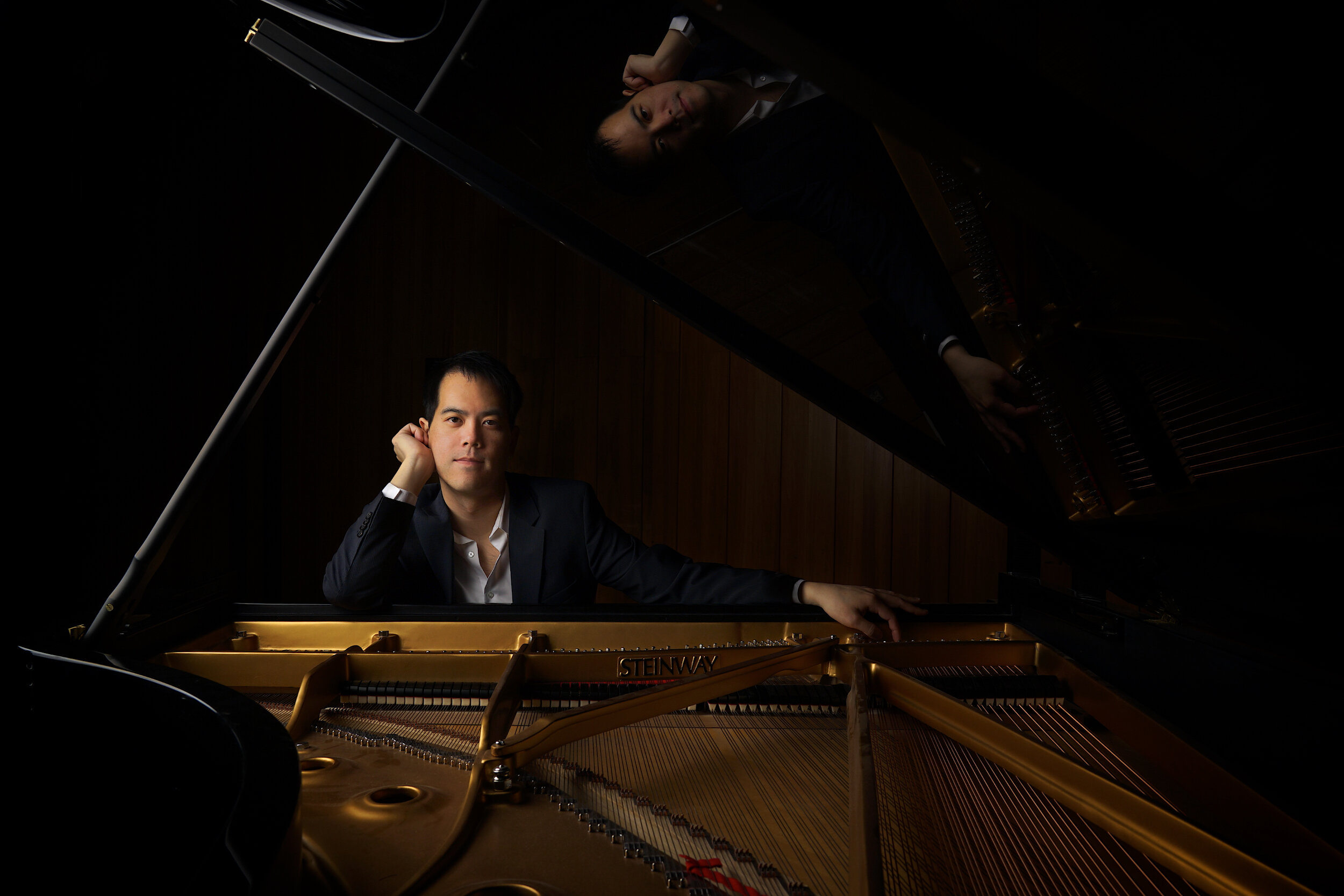"Désordre" And My Journey Through Ligeti's Music
Eric Huebner, credit: Vincent Lopez | Classical Post
My new album Désordre (New Focus Recordings: FCR 269) features music by the Hungarian composer György Ligeti and includes the first two books of his piano études along with his horn trio. The recording comes over twenty years after I first became familiar with his piano music.
While still a high school student, I had learned to admire György Ligeti's music from afar. I had seen Stanley Kubrick's film 2001: A Space Odyssey a few times growing up and knew the famous story of Kubrick jettisoning the score composed for the film and replacing it with selections from Strauss and Ligeti. Surely almost anyone who’s seen the film has been stunned by the breathtaking austerity and dark intensity heard in the excerpts from Ligeti’s Requiem, Lux Aeterna, and Atmosphéres. During the summer of 1997, between my sophomore and junior years at Juilliard, I was lucky enough to have several master classes with the famed French pianist Pierre-Laurent Aimard at the Darmstadt Summer Courses for New Music. When I returned home, I made a point of acquiring Aimard's recording of the first two books of Ligeti's études which had come out on Sony Classical earlier that year. Again, I was stunned. The music was hard to believe, especially the first etude, Désordre. How had Ligeti come up with that? How was Aimard even playing it? My roommate at the time, the composer Mason Bates, was as taken with the music as I was. We spent hours playing the recording on our living room stereo in Inwood, on the northern tip of Manhattan – where space and loud music are plentiful, trying to figure them out. Finally, I thought, I have to try and learn one of the études so why not make it the first one, Désordre?
Space Odyssey 2001
My First Experience With The Études
I remember visiting Patelson's Music House on West 56th street in Manhattan (may it rest in peace) and purchasing book one of the études. It turned out to be a published photocopy of the manuscript. How was I going to learn the music from this?! Ligeti's handwriting is mostly legible but small and often somewhat vertically misaligned – not ideal for reading such complex music. Nonetheless, throughout that fall and winter, I picked away at the first étude, playing it on my senior recital the following February. The learning process was painful. I would describe it as a combination of the most burdensome aspects of mastering a complex contrapuntal keyboard work like a Bach fugue combined with, say, needing the technical fluency required to survive a piece like Liszt's Feux Follets concert étude. Even now, all these years later, while certain aspects of playing Désordre or Autumne à Varsovie are more comfortable, every performance still exists on that very thin edge between survival and near total wipeout!
After this initial experience with the études, I wasn't especially eager to learn more (or even if I was, in truth I didn't). My two next experiences with Ligeti's music involved performances of the Chamber Concerto with Ensemble Sospeso in New York and coachings with the great horn player William Purvis at Juilliard on several movements from the Horn Trio. The second movement of the horn trio features music and an ostinato 3+2+3 pattern in the piano that Ligeti would use again in his fourth etude, Fanfares. The ostinato becomes an almost menacing force in the trio as other melodic lines and patterns played by the horn, violin, and second hand of the piano are set against it. Purvis had vast experience with the piece and seemed to know rather precisely what we would have to do in order to perform it successfully.
Ligeti’s Piano Concerto And An Opportunity To Finish Learning The Études
In 2006, I had my next major run-in with Ligeti's piano music. The conductor David Robertson asked me to learn and perform Ligeti's piano concerto as part of his Perspectives Series at Carnegie Hall. The opening of the first movement of the concerto resembles Désordre in its accented octaves played by all white notes in the right hand and all black notes in the left. The concerto’s third movement has some notable similarities to the sixth étude, Autumne à Varsovie, in its overlapping descending melodic lines. One of the better known études from the set, a descending melodic lament is set against a 16th note broken octave ostinato. There's a sense of slow motion falling in the piece but also a richness in harmonic effect. It presents the pianist with another major test of endurance as patterns pile up several times throughout, culminating in rapid fire accents.
A good excuse to finally perform all the études came in the fall of 2016 with an invitation, again from Maestro Robertson, to perform the complete set at the Pulitzer Gallery in St. Louis on a series produced by the St. Louis Symphony. Something must have happened, because they called me in September for a concert in early November. I had, in the intervening years, performed book one and the four études that comprise book three, which are among the last pieces Ligeti wrote. So, I dedicated myself to the urgent task of chiselling away at the études in book two that I'd never played: Fém, Vertige, Der Zauberlehrling, Entrelacs and Columna infinita– a work which has the power to literally freeze ones arms. Stylistic influences among the études are rather easy to identify: Javanese gamelan in Galamb Borong, Bulgarian dance rhythm (aksak) in Fém, and American minimalism in Der Zauberlehrling. However, as my former student Nicholas Emmanuel writes in his brilliant note to this recording, “One could easily plunge into an obsessive documentation of stylistic influences, which are so rich as to be virtually indigestible, but such an endeavor misses the forest for the trees.” He goes on to point out “Ligeti, like Stravinsky, made the difficult notion of ‘home’ a central concern in his music.”
The Horn Trio
In the 1970s, Ligeti made repeated trips back to his native Hungary, as Emmanuel writes, to “rekindle a relationship with the musical community of his homeland and reestablish himself as a ‘Hungarian’ composer.” This effort was ultimately abandoned, and the four movement Horn Trio, completed in 1982, was written after a period of four years when Ligeti did not compose a single work. It seems evident that the horn trio represents for Ligeti a significant first step in forging a new musical language that would sustain him through the remaining years of his life.
In addition to the previously mentioned connection between Fanfares and the horn trio’s second movement, one hears echoes of some of the études from book two (composed in the late 1980s and 90s) in the trio’s latter movements. The fractured march rhythm that opens the trio’s Alla Marcia third movement would find a dance-like expression years later in Fém. There is in the crashing climax of the trio’s final Lamento that resembles the middle section of L’escalier du diable where Ligeti abandons for a moment his intervallic games to unleash a wildes Glockengeläute (wild ringing of bells).
In 2012, a colleague at the University at Buffalo, the violinist Yuki Numata Resnick, suggested we perform the trio on a Slee Sinfonietta concert – the faculty chamber ensemble at the university. We were joined by Adam Unsworth, a mutual friend and frequent guest at the university, and in 2013 recorded the work thereby inaugurating the process of producing this CD. I am indeed very grateful for the support and encouragement I’ve received along the way and the opportunities I’ve been given to perform this music over the years. Without these opportunities this recording would not have been possible. The goal was always to rise to Ligeti’s challenge: laying bare the music's intricacies and keeping pace with its extreme technical demands while expressing its joy, poignancy and, at times, melancholy.
I hope you enjoy it.
Eric Huebner
Pianist Eric Huebner has drawn worldwide acclaim since making his debut with the Los Angeles Philharmonic at age 17. In January 2012, he was appointed pianist of the New York Philharmonic and currently holds the Anna-Maria and Stephen Kellen Piano Chair. In recent years, he has appeared as concerto soloist in works by Carter, Ligeti, Messiaen, and Stravinsky and in recital throughout the U.S. where his programs frequently position recent works alongside modern classics. Mr. Huebner won first prize at the 2002 Concert Artists Guild International Competition with Antares, a quartet comprised of clarinet, violin, cello and piano. He has recorded for Col Legno, Centaur, Bridge, Albany, Tzadik, Innova, New Focus and Mode Records. Mr. Huebner is Associate Professor of Music at the University at Buffalo (SUNY) and a member of the collaborative piano faculty at The Juilliard School where he teaches orchestral keyboard performance. He holds a B.M. and M.M. from The Juilliard School where he studied with Jerome Lowenthal. His first album for New Focus Recordings, Eric Huebner plays Schumann, Carter and Stravinsky was released to widespread acclaim in April 2015.












